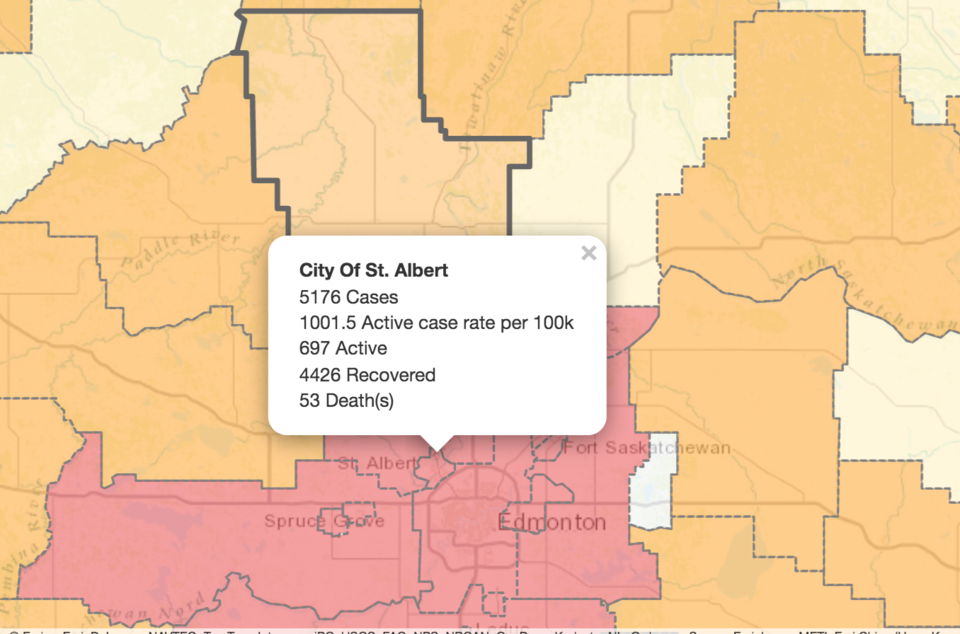Active COVID-19 cases have exploded in St. Albert.
Provincial data current as of Jan. 3 shows COVID cases have more than doubled to 697 compared to 344 reported last week.
Data shows Sturgeon County has 191 active COVID cases compared to 117 reported last week. Morinville's COVID cases have increased from 18 to 60 active cases.
During a COVID update on Tuesday, Jan. 4, Premier Jason Kenney called on the federal government to authorize the Pfizer COVID antiviral pill as cases and risks to the health-care system rise.
“We need to use every tool at our disposal, and this can be a helpful tool for our physicians and front-line staff,” he said.
Kenney asked Albertans to do three things to help relieve pressure off the health-care system, including getting vaccinated and getting a booster shot if already vaccinated; limiting personal contact; and using rapid tests when appropriate.
The province reported 34,276 active COVID cases across Alberta, with 436 COVID hospitalizations — 61 of which are people in ICU.
The province also reported 3,322 deaths from the virus, to date.
The positivity rate is 32.32 per cent, and ranged between 28 and 36 per cent from Dec. 31 to Jan. 3 — the highest positivity rate seen of any variant since the pandemic began, said Dr. Deena Hinshaw, Alberta's medical officer of health, at the press conference Tuesday.
New isolation requirements for COVID-19 kicked in on Monday.
On Dec. 31, Health Minister Jason Copping announced anyone with two doses of a COVID-19 vaccine who tests positive for the virus will be required to isolate for five days instead of 10 as long as their symptoms have fully resolved in that time.
However, if symptoms last longer than 10 days a person must isolate until symptoms resolve.
After the isolation period, people must wear a mask around others at all times when they are outside of their home for five days following their isolation period.
“We feel this is prudent given the evidence that shows that fully immunized people have shorter infectious periods,” Copping said.
Copping said the province is making these changes in line with new guidelines from the CDC and to help prevent disruptions to Alberta’s workforce.
Monday also marked the start of an extended winter break for students in kindergarten to Grade 12, with classes set to resume on Jan. 10 — a week later than most were set to go back.
Alberta’s Education Minister Adriana LaGrange made an impromptu announcement last Thursday stating the change was made because of concerns over the rapid rise of the Omicron variant and the impact it could have on schools.
Diploma exams, which were set to begin on Jan. 11, have also been canceled in recognition of the learning disruptions to older students.
“It's very hard for anyone at this time to fully assess what the situation for schools may look like,” she said Thursday.
LaGrange said the decision wasn’t made lightly and she appreciates the new challenges this additional week off presents to parents.
“I do hope that what I'm sharing today offers you some of the assurance that we are in fact taking this very seriously and of course always putting the safety of our students and our staff as our number one priority,” she said.
LaGrange said school authorities planned to use the week to gather more information and prepare for what the evolving COVID situation could mean for schools in terms of staffing and potential operational impacts as well as preparing for changes in COVID testing notification and reporting.
Starting Jan. 10, the province will distribute an initial 8.6 million at-home rapid tests to schools across Alberta, enough to provide two five-test kits to every student and staff member across the educational system, said LaGrange.
The province will also distribute 16.5 million medical-grade masks for staff and students.
“This will bring convenience and is an additional measure to lower risk of in-school transmission,” said LaGrange.
The change follows a shift in the PCR testing strategy that focuses on high-risk groups such as continuing care homes and those in health-care settings.
During a Dec. 31 update, Hinshaw explained the PCR testing strategy required the shift because of an extraordinary volume of COVID cases.
Hinshaw said broad testing was most applicable early in the pandemic when managing spread was the goal.
“We are in a very different place right now with respect to COVID. We have vaccines that are extremely effective at preventing severe outcomes,” she said.
Hinshaw said Omicron spreads quickly and individual-case contact management will not be effective.
“We must use proactive approaches rather than reactive ones,” she said.




